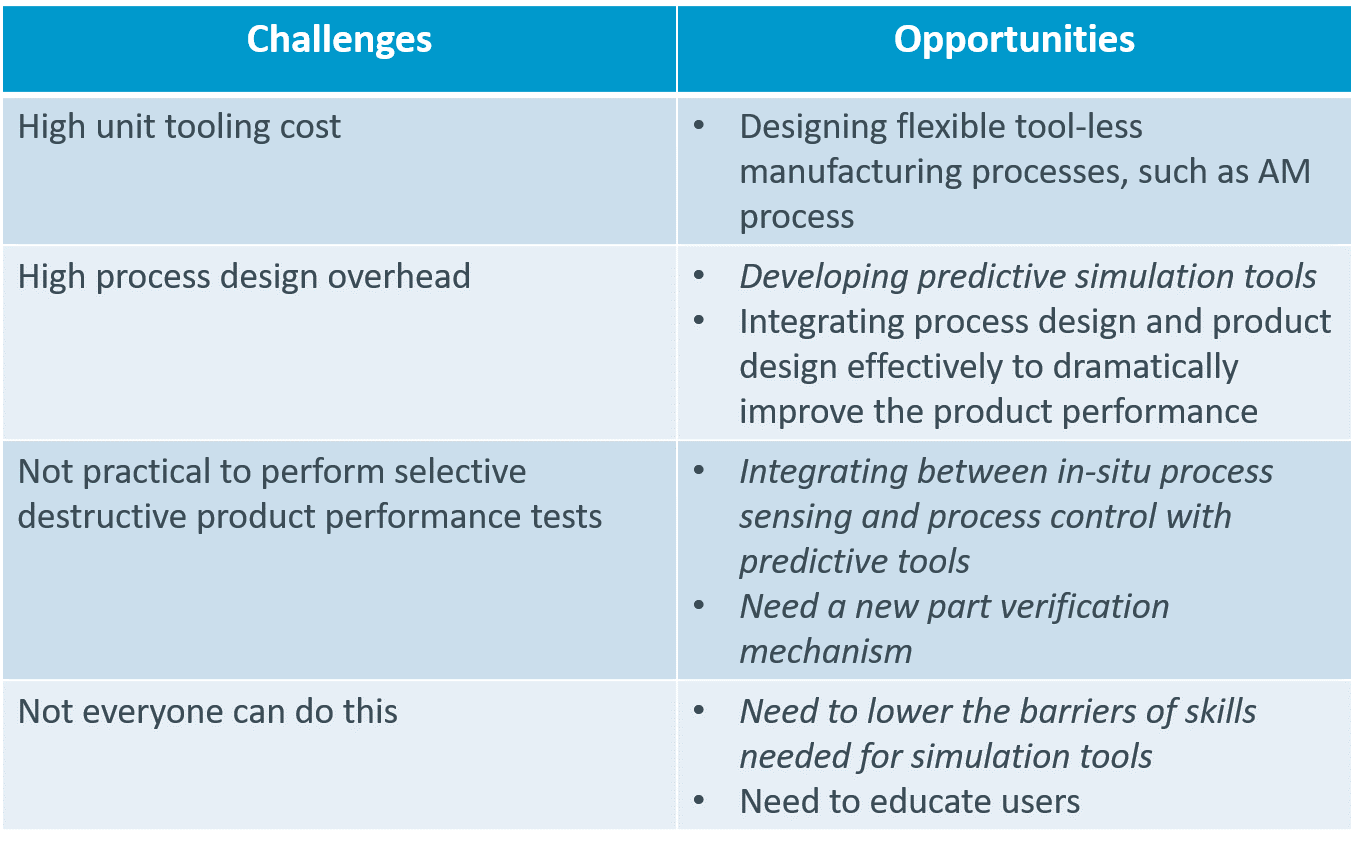Motivation
Table 1. Challenges and opportunities for low-volume flexible manufacturing
The market value of one-of-a-kind or low-volume metallic parts easily exceeds multi-billion dollars each year, considering new and legacy parts in aerospace or defense applications, tooling for mass-production, functional prototyping parts for new or legend cars, or patient-specific parts. Flexible manufacturing processes, such as additive manufacturing processes or incremental forming processes, provide exciting and promising means for high-value-added manufacturing. One critical challenge however, is to be able to certify the process for a specific production; how one knows whether the just-made, one-of-a-kind part can perform the desired structural or other functional requirements.
In this project, we develop a virtually-guided certification framework of metallic manufacturing processes using physics-based simulation tools and real-time sensors integrated by the efficient Bayesian update method. It will be achieved through a collaborative work among academia (Northwestern & Northern Illinois University), corporation (Siemens), and small businesses (QuesTek and PDA) with multi-dimensional technical backgrounds in manufacturing processes, materials, computational science, computer science, and software distribution.
Description
The objective of this research is to establish a foundation for rapidly certifying manufacturing processes using physics-based simulation tools and real-time sensors integrated by the efficient Bayesian update framework. We create three key capabilities that are currently missing in practices and that hinder rapid certification of fabricating one-of-a-kind products using novel manufacturing processes, which are:
A unified material data structure and process data structure for information needed by various parts in the digital manufacturing sequence, such that an individual material model or process model can be seamlessly linked as a plug-and-play module in the digital world;
An adaptive Bayesian inference algorithm to consider the uncertainty in physics-based computational models, that directs the updating of material parameters in the physics-based simulations using in-situ sensors;
A direct integrated framework of material microstructural evolution during the process, as well as its influence on mechanical properties, via an extremely efficient computational method, such that real-time updating is feasible.
Approach
Fig. 1. Foundation of verification framework
In this project, the research and development will be broken into the following tasks:
Task 1: Digital material structure
In this task, we develop a digital thread for materials based on microstructure and thermo-mechanical properties for improved predictive capability, including heat transfer, thermo-dynamics and particle movements. For this purpose, we use a dynamic and flexible data structure which links with common inputs such as forms of material (powder or bulk) and implicit time-, temperature- and rate-dependent behaviors.
Task 2: Digital process structure
This task focuses on providing a volumetric-based model powered by a process data structure capable of:
Dynamically generating analysis information
Storing experimental information
Encoding microstructural information of the product obtained from the digital material structure and in-situ sensors
Octree voxels is being used in order to selectively refine the voxel size, and thus to reduce the memory usage by the data structure.
Task 3: Low-volume certification methodology
In this task, we apply an adaptive Bayesian inference technique for efficient and cost-effective identification of key unknown parameters in the material model. The spatial random process models will be constructed as surrogates for the expensive simulation models. Markov Chain, Monte Carlo, and Gaussian process approaches are being proposed for this purpose.
Task 4: Simulation Software Integration
We also create a software framework to integrate together the different components needed to perform virtual validation of manufacturing processes and to facilitate the flow of information from overall input parameters to resulting properties of the manufactured part. It will be kept generic with respect to manufacturing processes. An interface with NX software will be developed. Compatibility with simulators for other processes, such as casting (PDA), will be considered.
Task 5: Verification and Validation
Finally, we will use experimental data for casting and additive manufacturing to calibrate the process model and verify developing framework.
Sponsor
Digital Manufacturing and Design Innovation Institute (DMDII)


